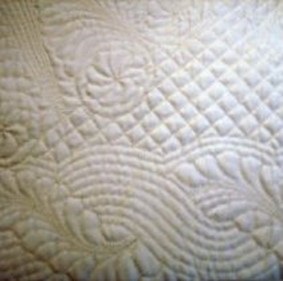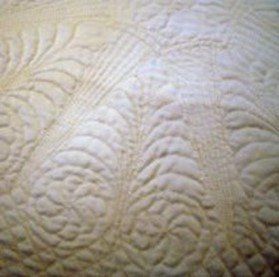Amy Emms, Honored for Services to Quilting
A somewhat belated Happy New Year to you all. I’m looking forward to so much in 2021; we’ll see.
Before I write about this week’s Honoree, I want to do a follow up on Mary McElwain. We had a comment from someone whose mother had shopped at the McElwain store and bought a kit which she never finished. The daughter isn’t a quilter and she wanted some information. With photos of the partially completed top, we were able to identify it as Marie Webster’s May Tulips. You may remember that McElwain had a good business relationship with Webster and carried several of her designs as patterns and kits. Here’s the one that’s in The Quilter’s Hall of Fame collection, in a different colorway than the unfinished one.
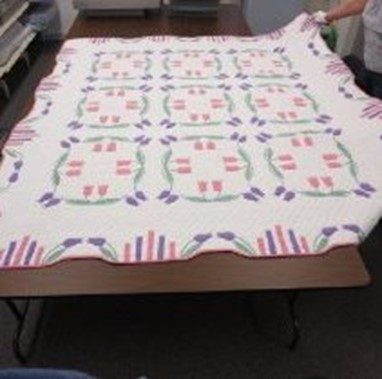
So, I hope this encourages you to leave me a comment if you have a question or reaction to a post. You should also know that TQHF has a searchable collection online if you want to research or browse—that’s how we found the photo above. You can get there easily; from the “About the Quilters Hall of Fame” button at the top of our website, drop down to “Collections” and follow the link to our PastPerfect platform. Not everything in the Collection is cataloged yet (the Collections Committee was set way back this year by not being able to have any work days), but you can still see many interesting pieces. Enough infomercial; on to Amy Emms.
Although many of our Inductees have honors and accolades beyond The Quilters Hall of Fame, only one has been honored by the Queen of England. Amy Emms was named a Member of the Most Excellent Order of the British Empire (MBE)—she got a medal like the one on the right.
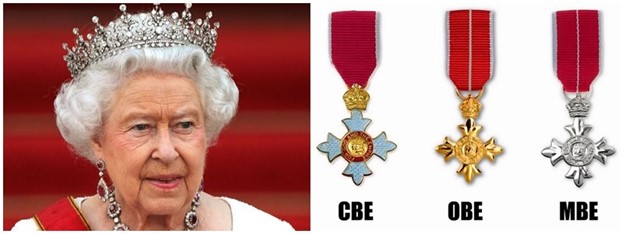
The award was made for her contribution to quilting, in recognition of her decades of work in preserving the cultural treasure of Durham or North Country style quilting. You can read all about Mrs. Emms’ life at the link below, and see a picture of her with her actual medal, but I’m going to touch on some extra “stuff” I found.
Amy Emms came from a home in a generally hard-scrabble area where quilting for hire supplemented the household income for the wives of farmers and widows of miners. Her mother, with Amy’s help as she grew up, earned extra cash by running a “club” in which she would find about twenty clients to buy quilts. They would pay her about one shilling a week until they had covered the full cost of the quilt. Under this scheme, a quilter could buy her materials and produce a quilt about every 3 weeks. Amy recalled that her mother sometimes worked until two or three in the morning. Listen to the brief interview in the link below to find out what Amy was paid for her first work—you’ll love her sweet voice, soft accent, and sly sense of humor.
A lot has changed in 100 years! Now teenagers get jobs at McDonald’s, and practically no one makes quilts for hire any more. Case in point: an acquaintance was looking for someone to make a baby quilt. I was unwilling to do it, even for a fee, so I asked my quilt guild. Not one of our 200 members was interested in doing the work. We’re all hobbyists, interested in the craft for our own amusement, not for income. And before you remind me that there are plenty of long-arm quilting businesses (quilt by checkbook, not by hand), I say the difference is that they serve the hobby community, and don’t make products for sale to the general community. I suppose you could argue that there are art quilters who make quilts for income, but I still demur because there is an element of personal/artistic expression that takes art quilters out of the quilting- for-hire, cottage industry that Emms was a part of.
Which is not to say that there isn’t artistry in Emms’ work. Here’s a quilt she made that was commissioned by the Quilter’s Guild of the British Isles for their collection.
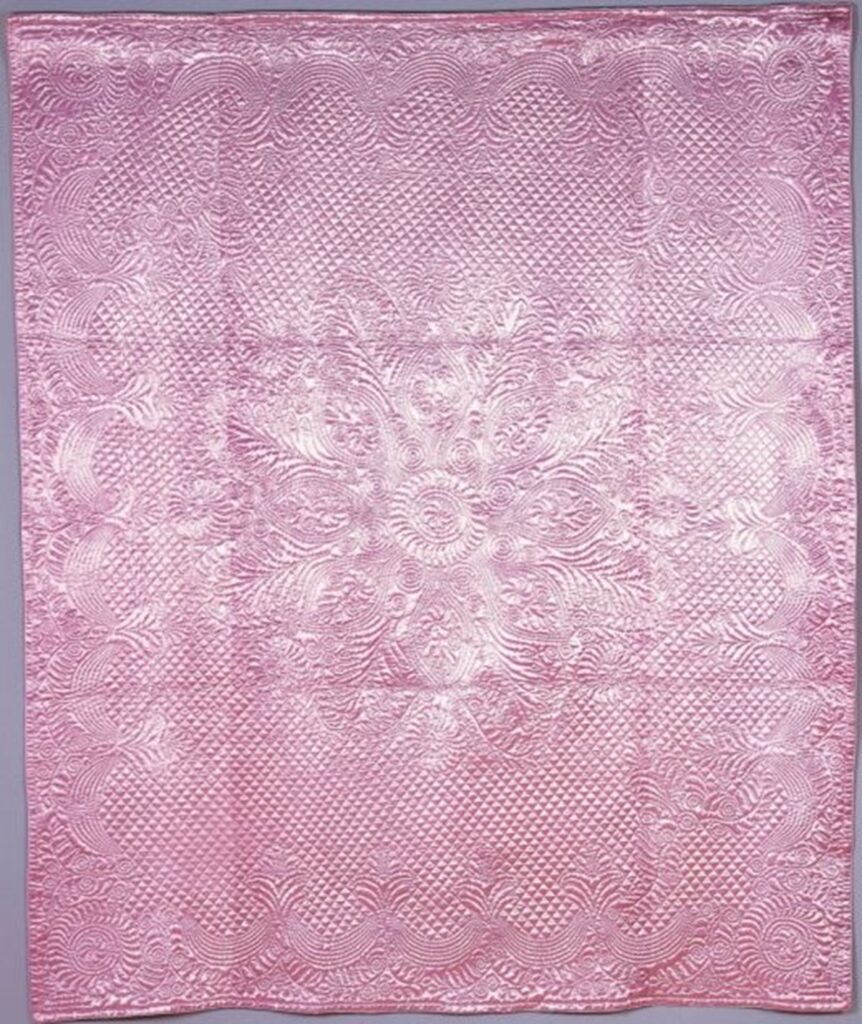
Next are a couple of close ups of the Emms quilt in TQHF’s collection, followed by a higher resolution shot from Barbara Chainey’s site, and then a detail of a quilt she donated to her local museum.
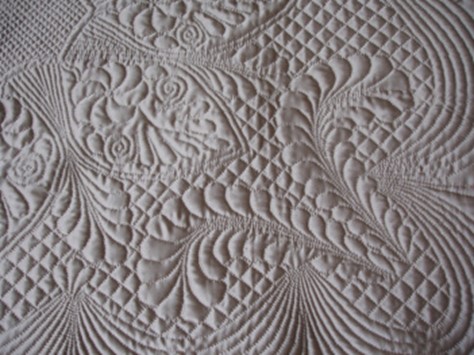
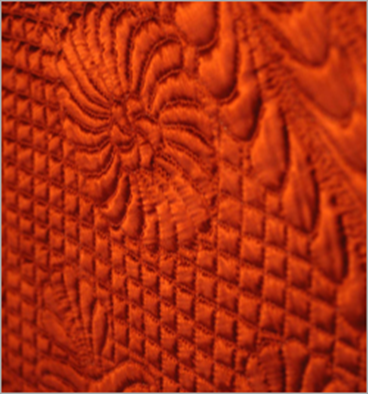
The layout of the pink quilt and the motifs of the others are typical of North Country quilting, and this is what earned Emms her MBE—preserving a regional craft which had been practiced in Northern England since before the Industrial Revolution. This style of quilting is generically under the label of “wholecloth” since they are neither pieced blocks, appliqué nor embroidery and the ornamentation comes solely from the quilting on a plain fabric. Favored quilting motifs were adapted from everyday objects such as flora, feathers, fans, shells, and stars; these were tied together in a flowing manner with wave patterns. When asked about trying new designs, Mrs. Emms replied, “We’ve tried all kinds but they never work like the old ones.” (Interview with Dr. June Freeman, 1983)
Emms wrote a book about her style of quilting. She uses the name “Durham” for the county of her home town, Sunderland. In recent times, County Durham has been consolidated into Tyne and Wear, so I’m using the broader term, “North Country”. If you are interested in more information about whole cloth quilting in England and Wales, and especially the differences in the styles, I’ve put a link below for an excellent blog entry on the subject. Here’s the Emms book; it’s widely available online.
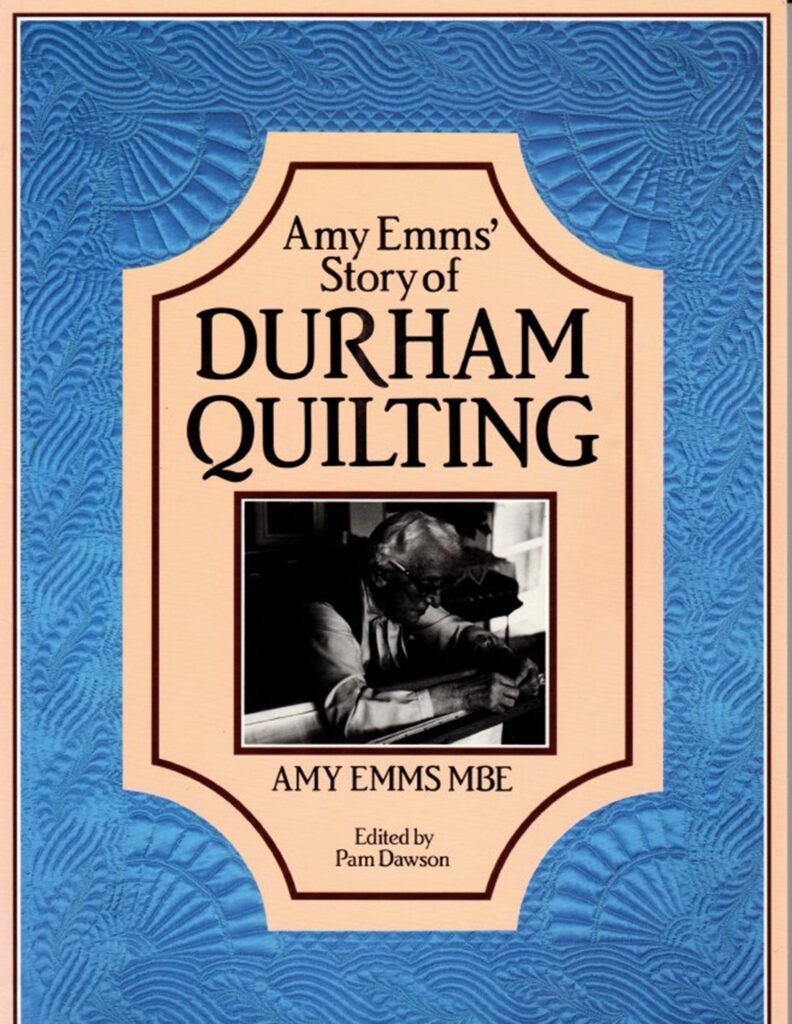
North Country quilting is also seen on cushions, dinner jackets and evening gowns. Amy Emms made a quilted wedding gown for her daughter, Olive. With typical Emms humor, Amy told Olive that she shouldn’t worry about the weight, and that “afterwards you could always make pram sets from it”. (Interview with Dr. June Freeman, 1983) Here’s a photo of Olive on her big day wearing what Amy referred to as a big round quilt. After the wedding, the dress was displayed at the Sunderland Museum.
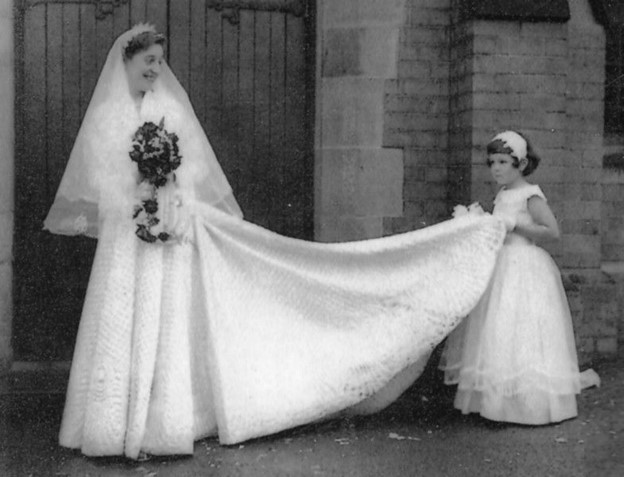
And here’s a stunning bit of quilting on that most mundane article of clothing—the housecoat. This one was made by a student of Emms in the 1960s.
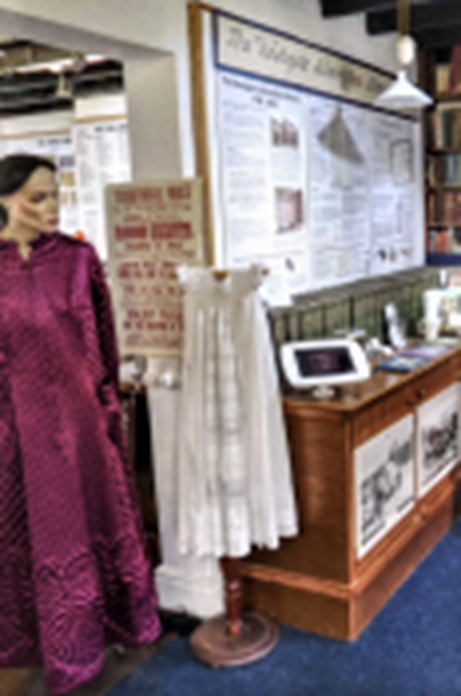
I mistakenly think of fashion quilting as starting with Honoree Virginia Avery in the 1970’s, but these examples are a few decades before that. I’m always learning! And, by the way, I would definitely wear a housecoat that looks like that.
The housecoat is my segue to the other “service” that put Emms on the Honours List: her teaching. After winning top prizes in local contests for eight years in a row, she decided to give others a chance, and she turned to teaching. She started during the Second World War through the British Legion organization which promoted fund-raising activities, and she continued giving evening classes for almost two decades. After Olive’s wedding dress was seen, locals had to enter a lottery to gain a place in Amy’s classes. Here are two photos of Emms’ teaching efforts.
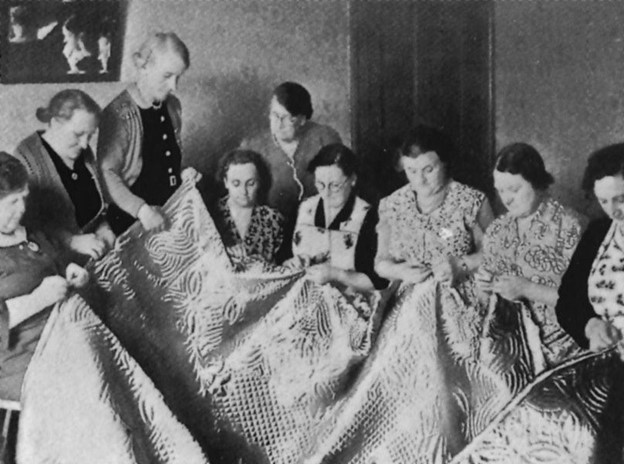
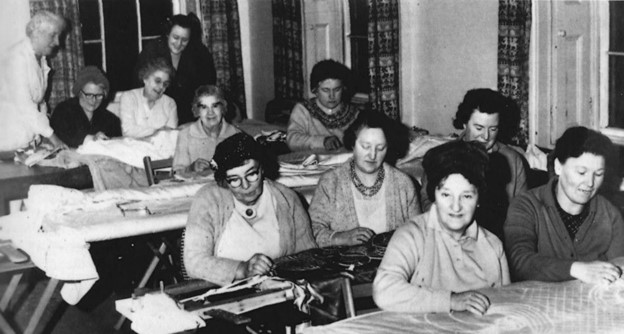
Emms’ legacy continues to this day, and her name is preserved in the Amy Emms Memorial Trophy presented at the annual British National Quilt Show, Quilts UK . The Quilter’s Guild of the British Isles also keeps her spirit alive through a Bursary (grant or fellowship) awarded biennially in her name.
I’ll close with a photo of Mrs. Emms doing what she did best.
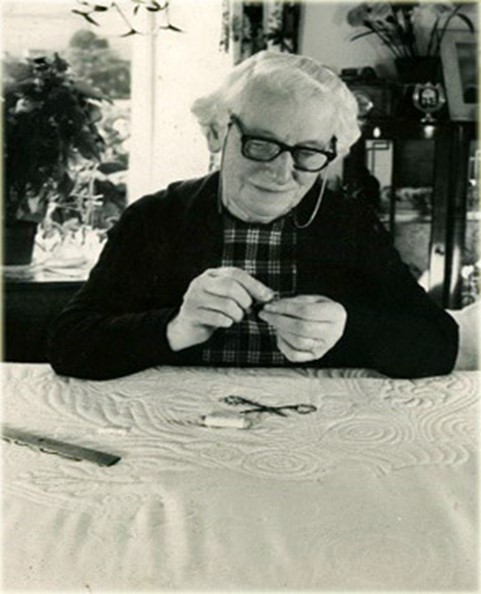
Your quilting friend,
Anna
PS. This almost makes me want to do some hand quilting, but I know myself better than that!
Bio information https://quiltershalloffame.net/amy-emms-m-b-e/
Interview about economics of quilting Interview https://www.gettyimages.com/detail/video/exhibition-of-quilts-at-london-crafts-council-amy-emms-news-footage/809794592
TQHF quilt https://quiltershalloffame.pastperfectonline.com/webobject/CB1A8218-3C1F-4094-8834-552172864358
More on quilting styles http://welshquilts.blogspot.com/2012/01/difference-between-welsh-and-durham.html
